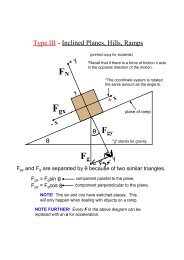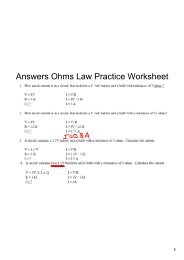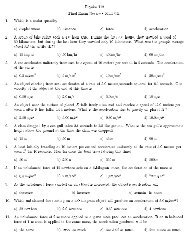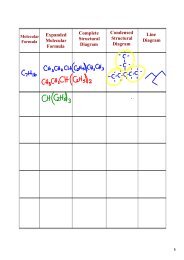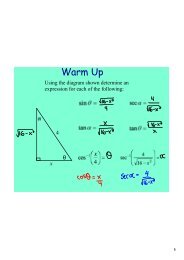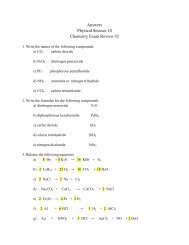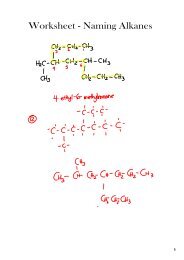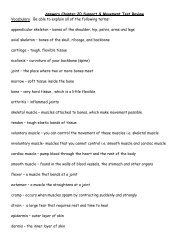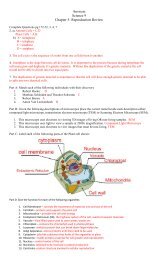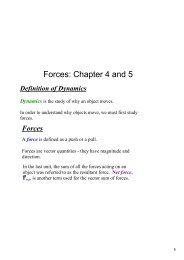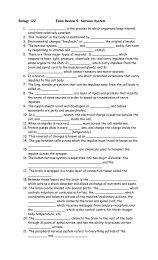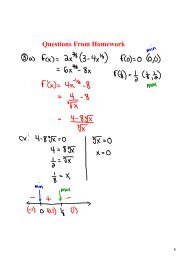Physics Study Guides.pdf - James M. Hill Memorial High School
Physics Study Guides.pdf - James M. Hill Memorial High School
Physics Study Guides.pdf - James M. Hill Memorial High School
You also want an ePaper? Increase the reach of your titles
YUMPU automatically turns print PDFs into web optimized ePapers that Google loves.
Geometric OpticsBig Picture<strong>Study</strong> <strong>Guides</strong>The principles of geometric optics describe the interactions of light on a macroscopic scale. Geometric optics is mainlyused to determine how light will change direction and form images through reflection or refraction. The path of light isapproximated by rays that travel in straight lines. All angles regarding reflection and refraction are measured from thenormal, which is a line perpendicular to the surface the light is interacting with.Key TermsReflection: When light travels away from an object at the same angle that it hits the surface.Normal: Line perpendicular to the surface of interest.Refraction: Occurs when light changes the medium it is moving through.Snell’s Law: Determines the angle at which a ray of light refracts.Total Internal Reflection: Occurs when the light ray’s incident angle is greater than the critical angle, causing all ofthe light to be reflected back into the original medium.Image: An image forms where rays of light coming from an object seem to converge.Real Image: Forms where the path of the light rays actually do converge.Virtual Image: Forms whre the light rays actually converge.Focal Length (Focus): The point where originally parallel light rays converge when they reflect off a curved mirroror refract through a lens.Lensmaker’s Equation: Allows us to calculate the focal length of a lens based on the material and curvature.Reflection and Refraction<strong>Physics</strong>Disclaimer:When light hits a surface, it always reflects away from the object at the same angle that it hits the surface. The angleis measured relative the normal. Depending on the surface, two types of reflection are possible:• Specular Reflection: Rays of light reflect off a smooth surface parallel to each other. This means it is possible to seethe original image that hit the surface. All mirrors employ specular reflection to display an image.• Diffuse Reflection: When rays of light reflect off a rough surface, light reflects in all directions due to surfaceirregularities.Light refracts when it travels from one medium to another (examples: from air to water, from glass to air). Light willchange direction when entering a new medium because it will travel at a different speed in the new medium.• How much light changes direction is determined by the medium’s index of refraction, the ratio of the speed oflight in a vacuum to the speed of light in the medium, and the incident angle of the light ray. This relationship isdescribed by Snell’s law.• To a lesser degree, the angle of refraction also depends on the wavelength of light being refracted.• All mirrors use specular reflection to create an image. Lenses are special shapes made of transparent material thatrefract light into an image.Depending on the angle, an interesting phenomenon called total internal reflection can occur. Whenever light ismoving from a medium of a higher index of refraction to a medium of lower index of refraction, some of the light isreflected back into the original medium. If the angle is greater than the critical angle, all the light is reflected.The criticalangle is the angle at which light is refracted at 90° from the normal (along the interface between the two mediums).Ray DiagramsImage Credit: Johan Arvelius, CC-BY-SA 2.5This guide was created by Christopher Addiego and Catherine Wu. To learnmore about the student authors, visit http://www.ck12.org/about/about-us/team/interns.Image Credit: Marcelo Reis, CC-BY-SA 3.0Ray diagrams illustrate the path of light when it interacts with mirrors and lenses.• If the light is interacting with a mirror, it will reflect off the surface.• If the light is interacting with a lens, it will refract through the lens.Light from an object hitting a mirror or lens is approximated by two or three arrows that go towards the top, center,and bottom of the mirror or lens. Since ray diagrams are approximations, we will not need to calculate any specificangles of reflection or refraction.Page 1 of 3v1.1.10.2012this study guide was not created to replaceyour textbook and is for classroom or individual use only.




